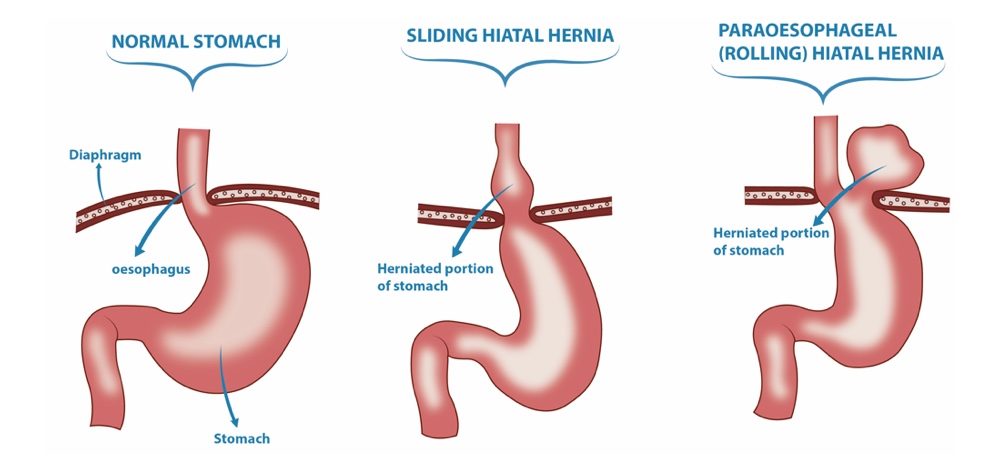
Phrenoesophageal ligament (PEL) attaches to the esophagus at the GEJ.Normally lies at the level of the esophageal hiatus.Left and right paravertebral tendinous crura.Central opening of the diaphragm, which allows the esophagus to pass through into the peritoneal cavity forms the upper part of the esophageal sphincter and the reflux barrier.Also see our article “ Congenital diaphragmatic hernias”. All symptomatic PEH, mixed, and complex hiatal hernias require operative intervention to avoid life-threatening complications. Patients with PEH or mixed hiatal hernias typically present with intermittent dysphagia, substernal discomfort, or abdominal pain, and in rare cases present acutely with gastric volvulus and strangulation. Symptomatic patients with sliding hiatal hernia present with features of gastroesophageal reflux disease ( GERD), which are usually managed with lifestyle modification and proton pump inhibitors. Nearly half of all patients with hiatal hernia are asymptomatic and require no medical or surgical intervention. Complex hiatal hernias are rare and characterized by protrusion of any abdominal organ other than the stomach. In paraesophageal hernias (PEH), only the gastric fundus herniates into the thorax, whereas in mixed hiatal hernias, the GEJ as well as the gastric fundus herniate. Sliding hiatal hernias, where the gastroesophageal junction ( GEJ) and the gastric cardia migrate into the thorax, account for 95% of hiatal hernias. There are four types of hiatal hernia: sliding, paraesophageal, mixed, and complex. It may be congenital or secondary to ageing, obesity, and/or smoking. Call us at Turnquest Surgical Solutions, send us a message here on our website, or use our online booking feature to set up an appointment today.A hiatal (or hiatus) hernia is the abnormal protrusion of any abdominal structure/organ, most often a portion of the stomach, into the thoracic cavity through a lax diaphragmatic esophageal hiatus.


If your symptoms become severe enough, you’ll need surgery for your hiatal hernia.ĭon’t wait for the problem to progress. The blood supply to the trapped portion of your stomach can lose blood flow and result in serious illness, so it’s important to seek treatment at the first signs of illness. Leaving a hiatal hernia untreated can result in pain and serious illness. Symptoms of pain and discomfort usually pass within 48 hours, and the procedure can be performed in an outpatient setting. We use this method because it involves only a few incisions in your abdomen, less pain, and reduced recovery time. A laparoscopy uses a laparoscope, a thin tube with a light and camera, to help guide the operation. While there is no specified cause of a hiatal hernia, there are some potential contributing factors, including:Īt Turnquest Surgical Solutions, we treat hernias with laparoscopic surgery. You should see a doctor when your symptoms persist or it becomes unclear whether they’ll go away on their own. You can tell you might have a hiatal hernia when you experience symptoms such as: So we’ve compiled this handy guide to help you better understand hiatal hernias. Brandon Fadner, believe in keeping our patients informed about their health and well-being. At Turnquest Surgical Solutions, our doctors, Dr. Hiatal hernias are so common that by age 60, up to 60% of people experience the condition to some extent. With this sort of hiatal hernia, a part of your stomach is stays stuck in your chest cavity. The fixed kindĪlso called a paraesophageal hernia, this kind of hernia doesn’t involve its counterpart’s sliding-up-and-down motion. When the pressure lessens, your stomach returns to its usual position over time and with gravity. This type of hiatal hernia happens when your hernia is the result of a sliding motion, which happens during periods of increased pressure on your abdominal cavity. The condition manifests in two ways: The sliding kind

A hiatal hernia is a condition where the top half of your stomach pops into your chest cavity, using an opening in your diaphragm.


 0 kommentar(er)
0 kommentar(er)
